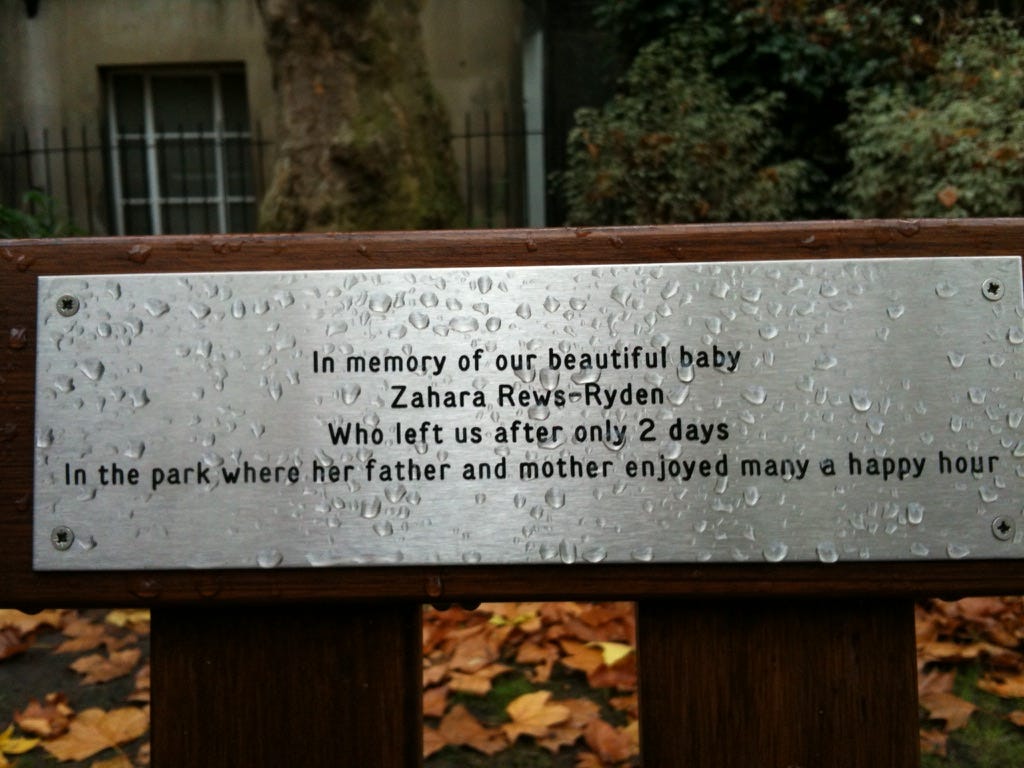Forget Me Not: How We Memorialise
Join me for a 'slow-cooker' series online where we explore memorialisation

You see something that stands out in the distance; a surfboard fin, a photo, a cross, wilted flowers, a letter or card, a teddy bear, and then the realisation sinks into your knowing like the tide disappearing into thirsty sand. Someone died here. Someone who was loved, ended their story at this place.
I am an avid collector of unconventional memorials and their stories: images, monuments and moments signifying life’s final page. Memorials are changing hand in hand with the way we commemorate death and remember life. Why not explore further with a ‘slow cooker’ series (my term for something that allows time for marinating and braising to enhance the flavour)?
The word ‘memorialise’ (memorialize for US friends) is the process of preserving memories of people or events so Wikipedia tells us. The words usage peaked around 1870 at the height of Queen Victoria’s reign. Back then death was more visible than it is today. It had to be. Death was everywhere. The term’s visibility has been on the rise again, sharply so from 2000 where the world witnessed 9/11 and the atrocities of the Iraq War.
The starting point for my upcoming six-part webinar series (one a month from 15/16 October to March 2025) Forget-Me-Not; how we memorialise has tendrils that reach back into my own timeline. If I were to mark a beginning for my fascination with memorials it was in the 2000s. I reported from the World War One battlefields of Passchendaele in Belgium and Gallipoli on a windswept Turkish peninsula. I reported from Israel and the Palestinian Territories. Iraq, Iran, Lebanon. I became interested in the hallowed ground where tragedies happened and wars were fought. But it’s also the smaller and more personal memorials that capture my attention these days rather than national sites and war memorials which receive funding and widespread attention.
After my mother’s death several years, I encountered the funeral industry for the first time. In a state of grief and weariness, my family sat in the meeting room of a well-known funeral director which promised to ‘craft the ideal funeral with exceptional service’. In grief, you don’t have the capacity to question deeply. You are in a funk. The ceremony happens, the funeral home hands over a USB recording and later, a box of ashes. It can feel quite clinical.
A century ago, cities regularly stopped for emotional funeral processions like this one in the Sydney suburb of Newtown in 1934. It turns out 1934 was a bad year for tram conductors including Henry Loxley:
Funerals rarely bring a city to a standstill these days. But in 2024 how important is it to commemorate a death and mark the end of a life? As a journalist and family history fan I am always looking for the creative ways that community marks the end of life.
Is it always necessary to preserve the memory of someone? No. Not everyone feels this need. People cope with bereavement and grief in different ways.

As usual, I begin an enquiry by casting a wide net. I am planning to explore pop-up shrines, digital memorials, the art of the eulogy, life stories. There’ll be more, but the beauty of slow-cooking is that you shouldn’t lay the table too early.
I’m so excited to introduce my first three guests in the Forget-Me-Not series:
Episode One: Tuesday 15 + Wednesday 16 October 2024 (US + Australia)
Gordon Coonfield, Associate Professor of Communication at Villanova University is the creator of the Kensington Remembers website which describes the street memorials of Kensington North Philly. If you want to read more in preparation. Here’s a start:
Episode 2: Wednesday 20 November 2024 (UK + Australia)
Peter Billingham is a professional eulogy writer who has written and delivered more than 700 eulogies. He’s from the United Kingdom and keen to ensure the best possible ‘good words’. I can’t wait to discover his process and to learn more about this craft.
Episode 3: Tuesday 17/ Wednesday 18 December 2024 (US + Australia)
James Ware Ph.D is a retired business leader who, earlier this year, farewelled his beloved wife Cindy Booth Ware after fifty-seven years of marriage. He has generously agreed to speak with us about how he crafted Cindy’s online memorial using the skills he acquired over a long career.
Please note, if you register, and you can’t make the live event, you will be notified as soon as the recording is available. I’m delighted to be collaborating with the
on this one. And of course, as always I welcome your comments in my preparations.












Hi Jenny, it's 10 am Sydney time... so quite early for you in the West. If you subscribe, the video will be uploaded and you'll be notified very soon after that. Thanks for your interest and here's the registration link: https://us06web.zoom.us/meeting/register/tZIscu6rpj0rGNc6PpgAAZMTVQEYYuk3vjpT#/registration
I’m so looking forward to being a guest Jane, thank you. I thought I was the only one who stopped at benches, roadside shrines or a porcelain heart hidden in a bush and wondered of the story and the life, and the person. Look out for ‘Paws and Petals’ a Sundial Series post later this month. It’s a story of a beautiful memorial, for a special friend in my local park. It will be a fascinating series.